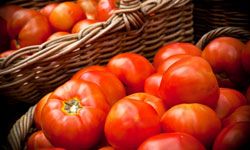Bringing home fresh produce can be really frustrating. Too often, fruits and veggies deteriorate mere days after purchase, leaving would-be eaters aggravated and stuck cleaning up a mushy -- maybe even moldy -- mess. As a general rule, it's best to eat any produce as quickly as possible after harvest because nutritional value and flavor go downhill pretty quickly afterward. Since those are the two main characteristics most of us look for in tomatoes, it pays to eat them sooner rather than later.
Before we spill the beans on what you should do to keep tomatoes fresh, you need to learn what not to do. Above all, never refrigerate whole tomatoes. Doing so will ruin the texture of the fruit (yes, tomatoes are fruits) and turn firm, red orbs into withered, mealy blobs. Plus, colder temperatures put a halt to the activities of flavor-producing enzymes within the tomatoes, totally impairing the ever-so-scientific "yummy" factor.
Advertisement
Read the next page to learn what method of saving fresh tomatoes isn't just for the birds.



